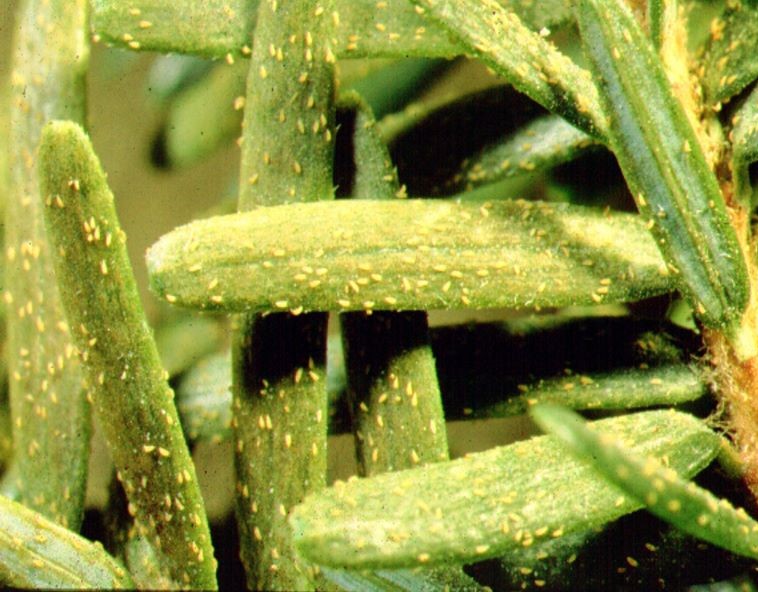Cool Season Mites (Eriophyidae)
GDD Window (base 50): 7-363, depending on species
Overview:
- Tiny, often “carrot-shaped,” translucent white
- Can only be seen with magnification (1/100″ in length)
- Usually two pairs of legs
- Live on host plant leaves
- Can cause leaf bronzing (“rust”)
- Some produce galls on leaves, buds, or flowers
- Some cause leaf-curling or witches’ brooms
- Disfiguration can occur
- Host plants: Some are host specific, while others attack many species of plants, trees, and shrubs
- Conifers and Broadleaf Evergreens
Management:
Cultural Practices:
- Natural predators: predatory mites (Phytoseiulus persimilis, Amblyseius andersoni) and Stethorus punctillum (predatory beetle), depending on species of mite
- Companion plants: basil, cilantro, chives, garlic, nasturtiums, marigolds, onions, oregano, rosemary, thyme
- Use resistant plant varieties
- Reduce plant stress
- Prune affected plant material
- Avoid overwatering
Materials:
- Contact insecticides:
- Pyrethroids [3]: Bifenthrin, Deltamethrin, Permethrin, Pyrethrin
- Avermectins [6]: Abamectin
- Carbamate [1A]: Carbaryl
- Systemic insecticides:
- Organophosphates [1B]: malathion
- Neonicotinoids [4A]: Imidacloprid
- Considerations:
- Pyrethroids and carbamates will harm beneficial predators if present
Biorationals:
-
- Insecticidal soaps and oils. May require multiple treatments.
- Apply 7-10 days before bud break and again at bud break.
- Sulfur
- Full coverage necessary. Do not apply when temperatures are over 90F, or in high humidity
- Kaolin clay
- Full coverage necessary. Frequent applications required. Monitor plant response to avoid over-application.
- Insecticidal soaps and oils. May require multiple treatments.



Disclaimer – Materials do not cover all possible control scenarios and are intended for licensed professionals. Tradenames do not imply endorsement and are used as examples. You must strictly follow the label for each compound prior to use. Rutgers is not responsible form is used materials or damages thereof. The label is the law. Labels will provide detailed information on use and restrictions. Additionally, application intervals, compatibility, surfactant use, PHI, PPE, important and other key information is described in detail. Always discuss treatments with your local agents. Note: Neonicotinoids can only be legally applied in commercial agriculture settings by licensed applicators. Guidelines and recommendations made in this presentation are specific to the state of New Jersey.
